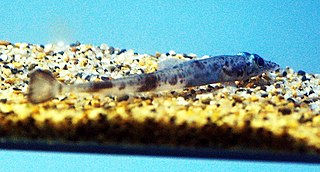
Nototheniidae, the notothens or cod icefishes, is a family of ray-finned fishes, part of the suborder Notothenioidei which is traditionally placed within the order Perciformes. They are largely found in the Southern Ocean.

Notothenioidei is one of 19 suborders of the order Perciformes. The group is found mainly in Antarctic and Subantarctic waters, with some species ranging north to southern Australia and southern South America. Notothenioids constitute approximately 90% of the fish biomass in the continental shelf waters surrounding Antarctica.

Bovichtidae, the temperate icefishes or thornfishes, is a family of marine ray-finned fishes, classified in the suborder Notothenioidei of the order Perciformes. They are native to coastal waters off Australia, New Zealand, and South America.

The Artedidraconidae, barbeled plunderfishes, are a family of marine ray-finned fishes, notothenioids belonging to the Perciform suborder Notothenioidei. The family comprises four genera. These fishes are endemic to deep waters off Antarctica.

Harpagifer, the spiny plunderfishes is a genus of marine ray-finned fishes, belonging to the family Harpagiferidae, it is the only genus in this monotypic family. They are found in the Southern Ocean.
Acanthodraco is a monotypic genus of marine ray-finned fish belonging to the family Bathydraconidae, the Antarctic dragonfishes, its only species is DeWitt’s dragonfish. They are found in the Southern Ocean and the southeastern Pacific Ocean.
Akarotaxis is a monotypic genus of marine ray-finned fish belonging to the family Bathydraconidae, the Antarctic dragonfish, its only species is Akarotaxis nudiceps. They are found in the Southern Ocean along the continental shelf of Antarctica.

Bathydraco is a genus of marine ray-finned fishes belonging to the family Bathydraconidae, the Antarctic dragonfishes. They are native to the Southern Ocean.

Mawson's dragonfish is a species of Antarctic dragonfish native to the Southern Ocean around Antarctica. It is found at depths of from 110 to 300 metres over the continental shelf. This species is the only known member of its genus.
Gerlachea is a monotypic genus of marine ray-finned fish belonging to the family Bathydraconidae, the Antarctic dragonfishes, its only species is Gerlachea australis. It is found at depths of from 200 to 670 metres over the Antarctic continental shelf. This species is the only known member of its genus.

The ploughfish is a species of Antarctic dragonfish native to the Southern Ocean around Antarctica. It is found at depths of from 0 to 550 m over the Antarctic continental shelf. This species is the only known member of its genus.

Parachaenichthys is a genus of marine ray-finned fish belonging to the family Bathydraconidae, the Antarctic dragonfishes. They are found in the Southern Ocean around Antarctica.

Prionodraco is a monotypic genus of marine ray-finned fish belonging to the family Bathydraconidae, the Antarctic dragonfishes, its only species is Prionodraco evansii. These fishes are native to the Southern Ocean.
Psilodraco is a monotypic genus of marine ray-finned fish belonging to the family Bathydraconidae, the Antarctic dragonfishes, its only species is Psilodraco breviceps. These fishes are native to the Southern Ocean.
Racovitzia is a genus of marine ray-finned fish belonging to the family Bathydraconidae, the Antarctic dragonfishes. They are found in the Southern Ocean around Antarctica.
Vomeridens is a monotypic genus of marine ray-finned fish belonging to the family Bathydraconidae, the Antarctic dragonfishes, its only species is Vomeridens infuscipinnis. These fishes are native to the Southern Ocean.

Chaenodraco wilsoni, the spiny icefish, is a species of marine ray-finned fish belonging to the family Channichthyidae, the crocodile icefishes. It is native to the Southern Ocean. This species is the only known member of its genus. It is of minor interest to commercial fisheries.

Cryodraco is a genus of marine ray-finned fish belonging to the family Channichthyidae, the crocodile icefishes. They are found in the Southern Ocean. While C. antarcticus has minor commercial importance, C. atkinsoni and C. pappenheimi are of no interest to commercial fisheries.

Dacodraco is a monotypic genus of marine ray-finned fish belonging to the family Channichthyidae, the crocodile icefishes, its only member is Dacodraco hunteri. This species is found in the Southern Ocean.

Notothenia trigramma is a species of marine ray-finned fish, belonging to the family Nototheniidae, the notothens or cod icefishes. It occurs in the southwestern Atlantic Ocean.














